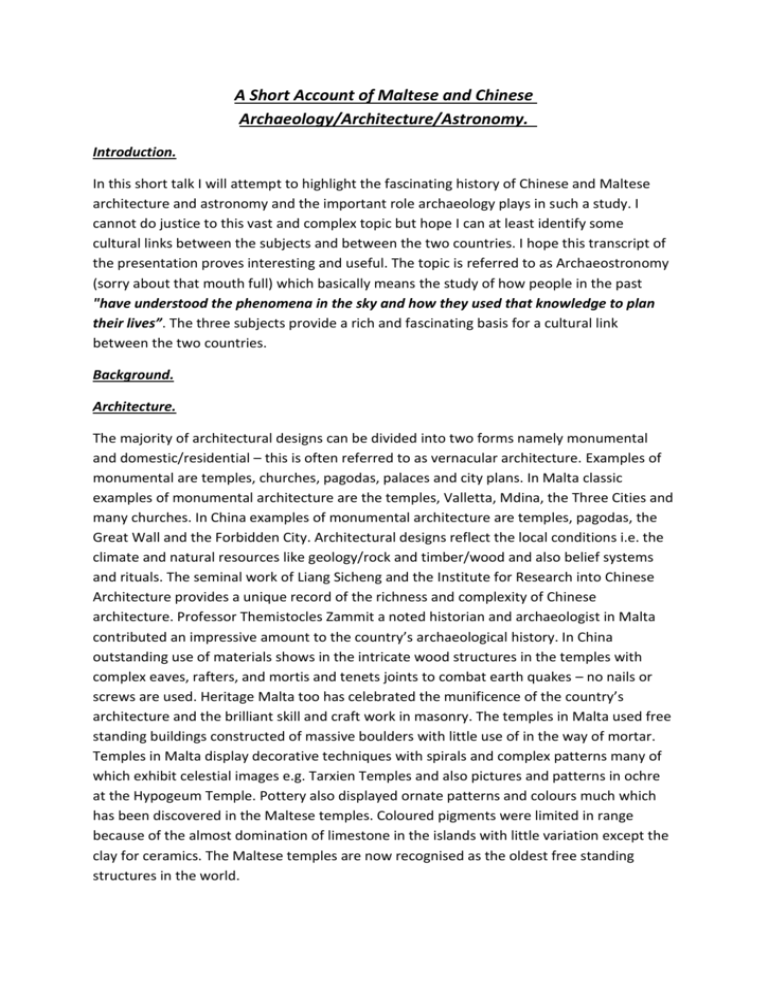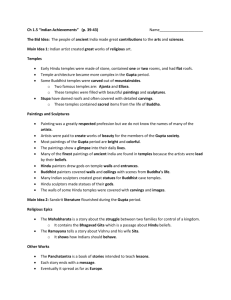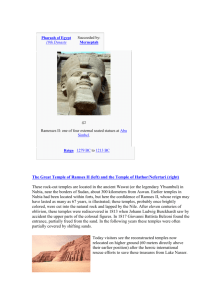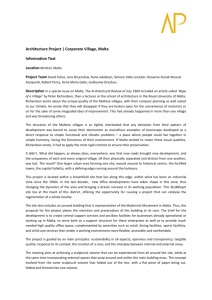here
advertisement

A Short Account of Maltese and Chinese Archaeology/Architecture/Astronomy. Introduction. In this short talk I will attempt to highlight the fascinating history of Chinese and Maltese architecture and astronomy and the important role archaeology plays in such a study. I cannot do justice to this vast and complex topic but hope I can at least identify some cultural links between the subjects and between the two countries. I hope this transcript of the presentation proves interesting and useful. The topic is referred to as Archaeostronomy (sorry about that mouth full) which basically means the study of how people in the past "have understood the phenomena in the sky and how they used that knowledge to plan their lives”. The three subjects provide a rich and fascinating basis for a cultural link between the two countries. Background. Architecture. The majority of architectural designs can be divided into two forms namely monumental and domestic/residential – this is often referred to as vernacular architecture. Examples of monumental are temples, churches, pagodas, palaces and city plans. In Malta classic examples of monumental architecture are the temples, Valletta, Mdina, the Three Cities and many churches. In China examples of monumental architecture are temples, pagodas, the Great Wall and the Forbidden City. Architectural designs reflect the local conditions i.e. the climate and natural resources like geology/rock and timber/wood and also belief systems and rituals. The seminal work of Liang Sicheng and the Institute for Research into Chinese Architecture provides a unique record of the richness and complexity of Chinese architecture. Professor Themistocles Zammit a noted historian and archaeologist in Malta contributed an impressive amount to the country’s archaeological history. In China outstanding use of materials shows in the intricate wood structures in the temples with complex eaves, rafters, and mortis and tenets joints to combat earth quakes – no nails or screws are used. Heritage Malta too has celebrated the munificence of the country’s architecture and the brilliant skill and craft work in masonry. The temples in Malta used free standing buildings constructed of massive boulders with little use of in the way of mortar. Temples in Malta display decorative techniques with spirals and complex patterns many of which exhibit celestial images e.g. Tarxien Temples and also pictures and patterns in ochre at the Hypogeum Temple. Pottery also displayed ornate patterns and colours much which has been discovered in the Maltese temples. Coloured pigments were limited in range because of the almost domination of limestone in the islands with little variation except the clay for ceramics. The Maltese temples are now recognised as the oldest free standing structures in the world. Astronomy. Astronomy is one of the earliest sciences. The resultant knowledge gained from careful and systematic observation of the planets, stars and their movement allowed an understanding of the changes of the seasons which then prompted when crops were sown, planted and harvested. Many early civilisations such as those of Babylon, China, Greece, India, Malta and Persia left detailed records of their study of astronomy. They were motivated by curiosity to understand the world, to the extent that they defined it, and beyond. In addition religion or the worship of supernatural powers played an important part in much of the pursuit of knowledge about the universe. China and Malta were amongst the earliest countries to develop astronomy. Archaeology. Archaeology is a relatively modern study of human activity in the past, primarily through the recovery and analysis of the material culture left by our ancestors. Archaeology is an example of a multi-disciplinary subject collecting evidence from many sources. The subject is both a science and humanity and collects evidence in the form of artifacts, architecture and building remains and from cultural landscapes. The subject studies human and cultural evolution to develop a greater understanding of cultural history - hence its centrality in this talk looking at astronomy and architecture. It looks at the evidence and makes judgements about the past and validates or refutes existing understanding and subsequently advances our knowledge of history and human life in the past. Cultural Links between China and Malta. There are many cultural links already between China and Malta which continue to strengthen and expand reflecting the warmth of the relationship between the two countries since the early 1970s. One important cultural link that needs to be more fully recognised and developed is that of science and technology especially astronomy and architecture where a number of similarities can be identified. One particularly fascinating element is the use of the temples and other structures in both countries for astronomical research in order to pursue a greater understanding of the seasons, time and the creation of calendars. This area has provided a very rich area of research in the past and can be further developed in the future to complement and enhance the existing cultural links between the two countries. I hope this small contribution helps in this endeavour. As one of the many scientific and technological interests in ancient China, astronomy, with the innovative calendars and surprising inventions, played an important role in the world's history of astronomical development. Astronomical achievements in China were closely related to the belief that the ancient emperors were mandated by the heavens. Like people of other cultures, the ancient Chinese and Maltese observed closely the sun, moon, stars and their movements. Malta. Commentators say that the Maltese association with astronomy could date from 5,500 years ago. There are the remains of 50 temples in Malta and Gozo in various states of preservation. In addition there are a large number of menhirs, stone rings and dolmens across the island many in sad states of repair and little research has occurred to ascertain their relationship to the temples. It is claimed that many more temples and stone structures existed but have been destroyed or still wait to be discovered. As a result of this deficit in their distribution no clear discernible pattern can be discerned and much more research is required to ascertain the relationships between the temples, the other larger complexes and other stone structures particularly their respective locations to one another. The structures are now, as mentioned above, recognised as the oldest free- standing buildings in the world a very remarkable fact. The Temple Culture is now considered part of the Neolithic Period is dated around the 3,600 – 2,400 BCE. A great deal of discussion and indeed argument over many years questioned the purpose of these structures and whether they had any astronomical significance including astronomical alignments. The Mnajdra temple was the only one initially to be identified to have links with astronomical research whilst the other temples were considered not to have any significant astronomical alignments. However recent research and archaeological investigation has shown clear evidence of predominance for the orientation of most temples to the winter solstice. In addition artifacts and furnishings discovered in the temples show that such activities as ancestor worship, animal sacrifice, places to communicate with gods and prophets and fertility goddess cults were performed. The majority of the Maltese temples are constructed to the same basic design: a central corridor leading through two or more ellipsoidal chambers to reach a small alter apse at the far end. All the walls consist of two faces, the space between being packed with earth or rubble. Doorways and passages all use the trilithon principle. Frequently doorways consist of a 'porthole', in which access is through a rectangular hole in the centre of a slab. Two different types of limestone were used in the construction of the temples; the hard, gray coralline limestone and the soft, pale globigerina limestone. Chinese Temples. The majority of temples in China are built of wood compared with Malta which used stone each capitalising on their geology and geography. Two typical Chinese temples are shown below. On the left is the Peoples Palace (Beijing) and on right the Temple of Heaven. The temples mainly build to venerate and celebrate the emperors and the dynasties are a complex design with intricate wood structures and brick very often with exact alignments to the south and north. Being of wood allowed them to be painted, the colours themselves having special relevance in regard to the emperors. Although it must be said that a number of temples in Malta used colours e.g. some of the stone tablets at Tarxien but time has eroded the colours. The supreme temple complex is to be found in the Forbidden City two views shown below: The temples in each country provides fascinating information about the role of religion, the veneration of emperors/rulers and astronomical observation. Time does not allow a detailed analysis of them instead I will focus in the case of Malta on the Mnajda temples which gives an insight into the role of astronomy played in its creation. Two vivid examples that provide strong evidence of an interest in astronomy and solar calculations on Malta and Gozo can be found from discoveries of everyday objects such as this broken limestone slab from the Tal-Qadi Temple, see above, which shows a representation of the heavens, depicting the moon and stars as well as a number of radiating lines dividing it into quadrants, and the solar-wheel often called to ‘the solar wheel’ from a pottery shard found in Hagar Qim temple, (which means standing stones). Mnajdra temple as mentioned above shows evidence of several significant alignments to mark moments of the solar year. The Tal Qadi stone shown above depicts that the sky was divided into sixteen sections. The Solar wheel shown above is divided into eight sections. It is now considered probable that most, if not all of the large prehistoric temples on Malta would have originally been covered over. Combined with an invariable orientation of the passages to either the equinoxes or the solstices, the builders would have been able to use the temples as a means of measuring the solar year exactly. Mnajdra temples are a good example to illustrate the architectural and astronomical aspects of the temples having been extensively restored. Above is a photograph of part of the temple and opposite a chart showing layout of the temples. Mnajdra consists of two buildings, a main temple with two ellipsoidal chambers and a smaller temple with one chamber. Among their other possible uses, the temples of Mnajdra fulfilled astronomical observation and calendrical functions. The main entrance faces east, and during the spring and autumn equinoxes the first rays of light fall on a stone slab on the rear wall of the second chamber. During the winter and summer solstices, the first rays of the sun illuminate the corners of two stone pillars in the passageway connecting the main chambers. As the sun crests the horizon on the spring and autumn equinoxes, Mnajdra consists of two buildings, a main temple with two ellipsoidal chambers and a smaller temple with one chamber. Among their other possible uses, the temples of Mnajdra fulfilled astronomical observation and calendrical functions. The main entrance faces east, and during the spring and autumn equinoxes the first rays of light fall on a stone slab on the rear wall of the second chamber. During the winter and summer solstices, the first rays of the sun illuminate the corners of two stone pillars in the passageway connecting the main chambers. As the sun crests the horizon on the spring and autumn equinoxes, 21 March and 21 September (when night and day are of equal length) its rays exactly bisect the huge Trilithon entrance to Mnajdra's Lower Temple, projecting a spot of light into a small shrine in the deepest recesses of the megalithic complex. The photograph, below right, shows the megaliths forming the outer and inner portals of the Mnajdra East Temple. There are a group of small pitted holes on the inner megaliths which record very accurately the helical rising of the stars over 5,000 years ago. To date, little serious research has been conducted on the celestial alignments of the Maltese temples. Further archaeological and astronomical studies are needed to reveal more detail particularly astronomical alignments. However, one astonishing fact that has emerged already concerns an astronomical/mathematical dating of the temples that is many thousands of years older than that assumed by orthodox archaeology. Similar arguments can be made about Chinese archaeology. In addition to their celestial alignments the Maltese temples also reveal surprising evidence of mathematical and engineering sophistication - the so-called Megalithic Yard of 2.72 feet. China. As one of the advanced natural science subjects in ancient China, astronomy, with the innovative calendars and surprising inventions, played an important role in the world's history of astronomical development. Like people of other cultures, the ancient Chinese and Maltese observed closely the sun, moon, stars and other visible heavenly bodies and their movements. A tower Beijing observatory built in 1270 CE measured the sun’s shadow which is shortest at noon and very short at the summer solstice with markers on the ground to locate shadow positions; compare this with the marking at the Mnajdra Temples – again great similaries between the two countries. Since the ancient Chinese believed that the perceived movements of the stars were closely related to the destiny of the country and its rulers, for thousands of years they recorded their movements with great attention. From the 16th century BCE to the end of the 19th century CE, almost every dynasty appointed officials charged with the sole task of observing and recording the changes in the heavens. Such observations and records have left a rich astronomical legacy. One of the main functions was for the purpose of timekeeping. The Chinese calendar was considered to be a symbol of a dynasty. As dynasties would rise and fall, astronomers and astrologers of each period would often prepare a new calendar to be made, with observations for that purpose. In China, as in many other cultures, there is evidence of interest and observation of the sky from many years earlier than written documentation suggests. Examples of pottery now held at the Beijing Ancient Museum and dated to the Neolithic period (over 5000 years ago) show images of the sun, and intricately carved animal shells and bones depict images of the stars as well as astronomical events such as star explosions which may date back as far as 1400 BC. Unlike any other country, China is the only place where astronomical observations took place uninterrupted for 4000 years and this surveillance led to many important astronomical discoveries. Special care was taken in China to record the appearance of unexpected events in the sky, such as eclipses, comets or star explosions. It is possible that the observation of the sky in a scientific sense was first undertaken as a way of marking time and recording events within a recurring pattern in order to create a calendar. A calendar marks the seasons and helps farmers to know when to plant and harvest their grain. As tradition dictated that the rulers of China, first kings and later emperors, should receive their political mandate from the sky, astronomy soon became a dominant science in China. The main responsibility of political power was to keep the Earth in total harmony with the sky. The stars themselves were bestowed with astrological meaning, both enabling predictions that influenced daily life as well as major political strategies, and thus astronomy swiftly became a powerful political tool. "[The Chinese] were the most persistent and accurate observers of celestial phenomena anywhere in the world before the Arabs." One of the oldest observatories in the world is situated in Beijing built in 1442 is shown below left. The image on the right shows an oracle bone with characters depicting celestial phenomenon. Interesting to note the similarity between this and the inscriptions on the stones found in Malta. Summary: As the existing cultural links between the two countries continue to develop I strongly believe a scientific and technological link would further enhance the relationship and I hope this small contribution helps that endeavour. Thank you. Richard Evans 2015. Glossary: Dolmen: Neolithic stone structure consisting of a horizontal stone supported by several vertical stones. Equinox: The time or date when day and night (twice a year) are of equal length (around 22 nd September and 20th March). Menhir: An isolated standing stone. Neolithic: That period when societies depended on horticulture and raising domesticated stock for their existence, using some ground stone tools. Solstice: Either of two times in the year when the sun reaches its highest or lowest point in the sky at noon. Marked by the shortest and longest days. Trilithon: Three large stones, a horizontal one supported at its ends by two vertical ones. Useful References: ‘Malta’s Temples’ by Klaus Albrecht. Sven Nather Verlag Potsdam 2007. ISBN 978-3-934858-15-2. 2007. ‘Malta before History.’ Foreword by C Renfrew. Miranda Publishers. ISBN 99909-85-08-1. 2004. (Excellent text). ‘The Neolithic Temples.’ Heritage Malta. ISBN 978-99932-6649-5. 2013. ‘China: A Short Cultural Account. C. P. Fitzgerald. Frederick A Praeger Publishers. 1961. The History of Chinese Architecture an excellent CCTV 9 Documentary. ‘Chinese Architecture – A Pictorial History.’ Liang Sicheng. MIT. ISBN 10 0486439992. 1984. Final comments. I have only highlighted a few of the archaeological gems of the two countries many others exist. For example: In Malta - the Towers/Redoubts, Fougasses, Cart ruts, the Catacombs, Roman remains etc In China - Tomb complexes, the Terracotta Army, Canals, Bridges, Stone Carvings e.g. Buddha etc.







